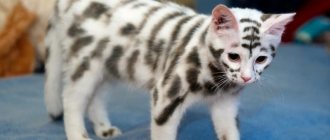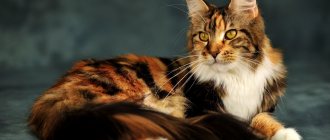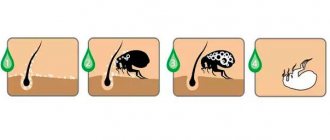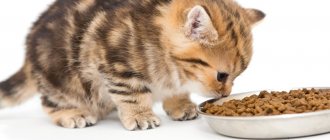Phasing bengal kittens
Phasing (fuzzy “fuzzy”, “vague”) is a phenomenon inherited by Bengal cats from their wild ancestors - ALC or otherwise Asian Leopard Cats. After all, to survive in the jungle, little leopards, beginning to explore the world around them, needed protection! What can protect babies if not a camouflage color?
Phasing in cheetah cubs
Let's remember the example of swans. All species of swans hatch with chicks covered in gray down. Their plumage is protective because a completely white chick would attract a lot of unnecessary attention. During the first three months they have some camouflage down, then they begin to gradually moult and acquire bright adult plumage.
The situation is approximately the same with our Bengal kittens.
Camouflage down of swan chicks
The cubs of all wild cats are susceptible to phasing. And little Bengals are no exception here - phasing “covers” Bengal kittens already at the age of one month and the first signs of adult color appear no earlier than four months (upon reaching eight months, the Bengal will take on the appearance of a spotted cat characteristic of this breed).
Be patient and the process of “cleaning” the skin of a Bengal kitten will give you many unexpectedly pleasant moments!
Phasing in Bengal kittens
Every day, the spots hidden under the grayish-whitish hairs will become brighter and more contrasting. The kitten will increasingly resemble its spotted parents, and will increasingly resemble a “little leopard.” And finally, upon reaching eight months, the Bengal will take on the characteristic appearance of a spotted cat. And the pleasant moments that the kitten’s growing up period will give you will fully compensate for its “unsightly” appearance in adolescence. Bengal cubs are playful, active and, at times, very “comical” - real clowns. The way a little kitten explores the world around him, sticks his curious nose into every hidden corner, into every box and fearlessly climbs into any package, will bring a smile to your face more than once.
So: don’t be afraid of phasing - it’s not a disease, and it’s not a deception. This is a normal development process for a Bengal kitten and only age can “heal” the baby. Have a little patience, and you will get the pet you dreamed of.
Breeders time after time are surprised by this miracle and even get upset about phasing. Knowing that a person who decides to buy a Bengal kitten will doubt that this “little one” will become a beautiful Bengal cat.
But for your peace of mind, do not hesitate to ask the breeder to show you the parents of the Bengal kitten you decide to buy. Take a closer look at the background and contrast. And if there are no problems with either one, calmly wait for the kitten to exit the phasing stage! You can even take a photo of your Bengal for a family album - treat this phenomenon with humor and wisdom. The same wonderful transformation that occurs with the ugly duckling awaits a Bengal kitten by the age of three or four months. Learn to be patient once you are fascinated by a Bengal cat!
And your patience will be justified - the phasing will go away, and you will have a Bengal kitten that will be the envy of your friends and acquaintances - a beautiful little leopard! Good luck to you!
Phasing in Bengal kittens
Fazing in Bengal cats
Phasing (also called phasing, fuzzing) is a process that all Bengal cat kittens go through without exception. Fazing (fuzzy) translated from English is fuzzy, blurry, indistinct, fluffy, fleecy, shaggy. All these definitions perfectly describe the manifestation of phasing. Those who are planning to purchase a Bengal kitten need to know that at approximately the age of one and a half to three to four months, the color of the kitten changes to “protective”. This is an inheritance inherited from a wild ancestor - the Asian leopard cat. Around this age, the grown offspring of wild cats emerge from their parent's nest into a world full of hungry carnivores. Their bright spotted fur can attract the attention of predatory animals and thereby cause the death of kittens. To protect them from mortal danger, nature creates a protective color for them, which in the wild is one of the conditions for survival. Their bright skin fades and turns gray, longer gray fur grows, which hides a clear pattern, thereby ensuring the kitten’s inconspicuousness against the background of the earth, stones and plants of wooded and semi-desert areas, which are the traditional habitats of these animals. From 3-4 weeks of age, a Bengal kitten becomes “nondescript”, entering the phasing stage. By 5-6 months of age, growing Bengal kittens will begin to return to their natural color, which will finally be established by 10-12 months.
If you buy a Bengal kitten during the phasing period from a professional cattery, do not worry - this is not a disease or a scam. This is just one of the periods of development of the Bengal and only time can turn the “ugly duckling” into a gorgeous cat with a clear, bright and expressive color.
But be careful if you decide to buy a Bengal kitten “cheaper”, “for yourself”, “without documents” in dubious places. At this age, phasing can be confused with ticking. Such a kitten will never be bright and contrasting again. In addition, a modest exterior is just one of the “troubles” that you risk acquiring if you want to save money on buying a Bengal kitten. Remember, only a professional nursery can guarantee the purity of the breed of your future kitten, its appearance, and compliance with the breed data. Do not try to buy a kitten without documents. At a young age, a kitten does not always have an appearance similar to that of an adult cat, so it is always problematic for a non-professional to verify purebred in the absence of documents. A kitten without documents is always a lottery. As a rule, kittens from cats whose owners are trying to hide either their origin or the presence of quite severe genetic diseases and defects do not have documents. Experts do not advise buying such animals even at a very attractive price.
Information
Phasing is a period of protective coloring in Asian leopard cat kittens in the wild. When kittens take their first steps from the nest, they face many dangers, incl. and large predators. Phasing partially helps protect against them. During this period, the bright spotted color of the kittens is shaded so that they are not so noticeable against the background of the surrounding nature. Let's remember the example of swans. All types of swans (both white and black) hatch chicks covered with gray down. Their plumage is protective because a completely white bird would attract a lot of unnecessary attention. During the first three months they have such camouflage down, then they begin to gradually molt and acquire bright adult plumage. The situation is approximately the same with our Bengal kittens. And so you booked a kitten, waiting for the moment when he could come to your home. Finally, you go to the breeder for your baby and - oh, horror! Instead of a beautiful spotted leopard, you see a “gray”, fluffy creature of an incomprehensible color... The breeder is trying to explain something to you, but what you see is not at all what you expected to see... Don’t be scared and don’t rush to be disappointed! This is not an optical illusion, and certainly not a deception of the breeder! The cubs of all wild cats are susceptible to phasing. And little Bengals are no exception here - phasing “covers” Bengal kittens at the age of one month and the first signs of “adult” color appear no earlier than four months. Be patient and the process of “cleaning” the skin of a Bengal kitten will give you many unexpectedly pleasant moments. Every day, the spots hidden under the grayish-whitish hairs will become brighter and more contrasting. The kitten will increasingly resemble its spotted parents, and will increasingly resemble a “little leopard.” And finally, upon reaching eight months, the Bengal will take on the characteristic appearance of a spotted cat. And the pleasant moments that the kitten’s growing up period will give you will fully compensate for its “unsightly” appearance in adolescence. Bengal cubs are playful, active and, at times, very “comical” - real clowns. The way a little kitten explores the world around him, sticks his curious nose into every hidden corner, into every box and fearlessly climbs into any package, will bring a smile to your face more than once. So: don’t be afraid of phasing - it’s not a disease, and it’s not a deception. This is a normal development process for a Bengal kitten and only age can “heal” the baby. Have a little patience, and you will get the pet you dreamed of.
Types of drawings
The coat of Bengals, according to the breed standard, is always patterned. There are 3 types of “Bengal” patterns:
- marble;
- spots;
- socket.
Marble color
The marbled bengal is the most expensive, since it is the hardest to get offspring of this color. The marble-like pattern with clear edges has an exclusively longitudinal orientation.
The Bengal cat's marbled pattern is unique; there is no other cat with the same pattern. The spots come in a variety of sizes and shapes, they are bright and evenly colored. Blurry edges and streaks are not acceptable.
Marbled kittens are born only by crossing parents with the same coloring.
Spotted
The spotted coloring is almost similar to the pattern on the body of the Bengal's close relative, the leopard. The shape of the spots is close to round. Longitudinal stripes are acceptable, but only on the shoulders.
Rosette
The pattern consists of ring-shaped spots of different shapes. There are three types:
- dart - with an elongated and pointed part of the outline;
- donut – round shape;
- paw - with an intermittent contour reminiscent of an animal's paw print.
The most valued pattern is with spots of the same size, located at approximately equal distances from each other.
Attention! The combination of large contours and the merging of spots into tiger stripes is considered a breed defect.
The muzzle is decorated with dark stripes on the sides, an “M” pattern on the forehead, and a ring-shaped pattern covers the neck. The shoulders may have small spots or a pattern resembling insect wings. The paws are covered with small spots, but striping is acceptable.
The tail is dark at the end, covered along its entire length with rosettes of rich color. The spots decorating the stomach, chest, and chin are lighter than the background color.











